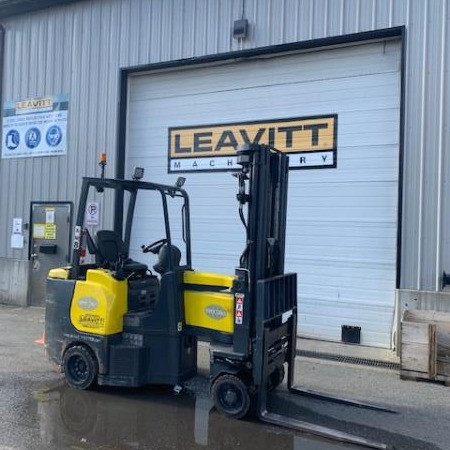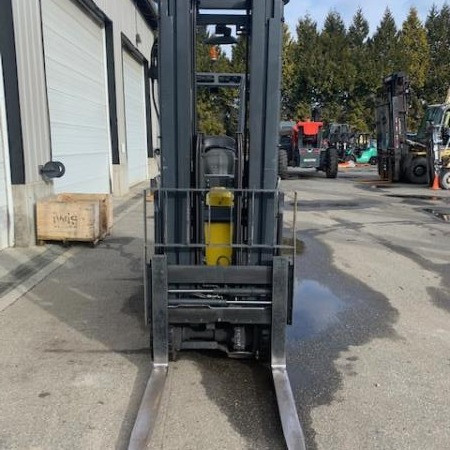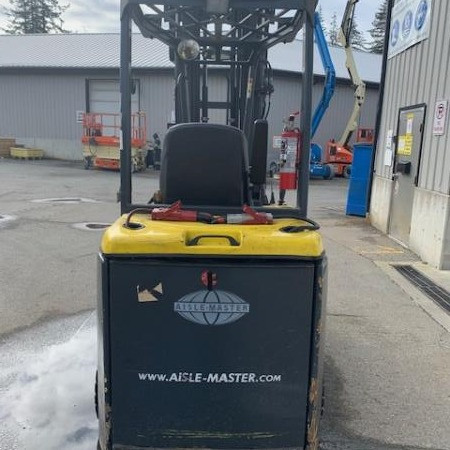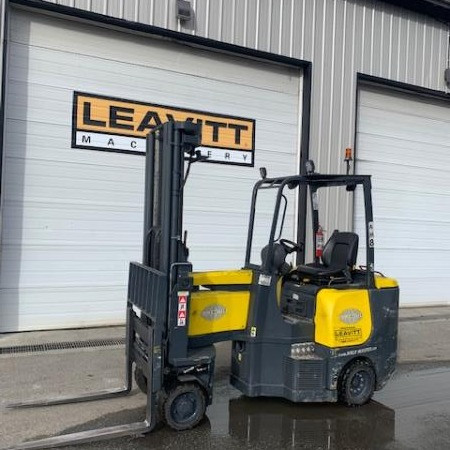Very Narrow Aisle Forklift El Monte
Used Very Narrow Aisle Forklift El Monte - Warehousing needs greatly focus on space-saving techniques and layout to maximize expensive square footage and decrease travel time needed to get goods from the loading docks and from point A to point B. Very narrow aisle solutions allow for more space to be dedicated to the storage of goods because less space is required for aisle access. Warehouse optimization consists of warehouse configurations.
Warehouse Optimization
There are several significant benefits of implementing very narrow aisle warehouse optimization.
Using narrow forklift trucks instead of traditional forklifts can enable the warehouse width of the aisles can be lessened to half. Numerous narrow aisle forklifts deliver better stacking heights to increase the storage capacity on a square foot basis. Very narrow aisle forklifts can greatly reduce costs compared to traditional forklifts since the same amount of stock takes up less space in the warehouse. In most urban areas where square footage is very costly, this is a huge benefit to warehouse operations. When planned carefully and properly, it is possible to increase warehouse storage area by up to 80 percent by implementing a very narrow aisle width configuration. Very narrow aisle design facilitates greater product access and more rack faces. Reduced travel time for storing items and gathering products are some of the key benefits to this warehouse layout as more products are found in an accessible location.
It is common for warehouses to use a very narrow or narrow aisle layout. Narrow aisles are usually those that use less than 11 feet of aisle width. Very narrow aisles usually use an aisle width of approximately 6.5 feet across. Both of these aisle widths provide significantly increased storage opportunities. Using a forklift for order picking and stocking can be difficult in these aisle widths, especially when turning. To meet these challenges, several different types of very narrow forklifts have been specially developed for various types of tasks to allow easier maneuvering in narrow aisle widths.
It is necessary to know the dimensions of the aisle when selecting a forklift for a certain job. It is important to have the correct aisle dimensions before forklift shopping to avoid securing a machine that won’t fit its’ intended location. Finally, it is critical that any utilities, posts or columns are taken into account before settling on a specific narrow aisle forklift design as these may affect access to aisles by some forklifts or prevent warehouse optimization.
Very Narrow Aisle Forklift Trucks
As these units are mostly powered by electricity, rechargeable batteries are popular for very narrow aisle forklifts. These very narrow aisle trucks are more commonly available as stand-up riders, which helps increase productivity and operator comfort. The most popular kinds of very narrow aisle forklift trucks include turret or swing-mast, end-control riders, order pickers and reach trucks.
Reach Forklift Trucks
Developed as a kind of rider stacker forklift, the reach forklift trucks can be configured for narrow aisle locations. It got its name by its function of reaching its forks forward to get to a load. There are two types of reach trucks: the moving mast and the moving carriage. The moving carriage works by raising and lowering the carriage, along with the operator. The moving mast works by raising and lowering the forks along the mast, while the operator stays at ground level. The moving reach truck is typically considered the safest out of the two kinds of reach trucks. These machines rely on a kind of jointed framework known as a pantograph system that enables the operator to place a load or reach the load without moving the machine.
Order Pickers
Order pickers were created to specifically pick orders from difficult-to-access racks. They are used for smaller picking items that can be lifted and moved by hand. These order pickers work by lifting the operator up to the level of goods in order to identify and pick the specific item or items necessary to fill an order.
End-Control Riders
End-control riders are used to pick loads located at floor level and transport the load horizontally, rather than lift or lower loads from various heights.
Turret or Swing-Mast Forklift
Turret or swing-mast very narrow aisle forklift have a pivoting articulating swivel mast. The mast swivels allowing pallets to be placed on either the left or right of the forklift.
Guided Very Narrow Aisle Trucks
Rail or wire can guide the very narrow aisle forklift trucks down the aisle securely.
Since the forklift truck is guided, the chance of colliding with racks while traversing down the aisles is very low. For rail-guided systems, a series of rails are installed into the floor, on both sides of the aisle, and run along the floor for the length of the aisle, curving around the end of the aisle. Wheel guides on the forklift slide into the floor rails to stop the machine from traveling out of bounds.
The wire-guidance system requires that the wires be installed into the floor, along the center of the aisle. Narrow aisle forklifts rely on a wire-guide system to help it communicate with the floor wires. This allows the machine to be steered by the wires, stopping it from traveling outside of the specific location.
Work Site Considerations
To use a narrow aisle configuration, there are some key considerations that need to be made. Because these very narrow aisle configurations include very tall racking systems, the condition of the floor and the construction of the racks must be done properly in order to avoid potentially disastrous outcomes. Four specific areas need to be perfectly prepared before a racking system can be implemented including a level floor, plumb racks, any floor cracks need to be repaired and the floor’s load capacity must be accurate. These locations need to be maintained and monitored continuously.
Level Floor
Due to the racking system height, any minor floor slope can gravely impact how plumb the racks are, particularly over time if loads are placed and removed repeatedly on the racks. The height of the racking system means that any minute floor slope can have a negative impact on how straight the racks are, especially over time when loads are continually removed and placed on the racks. Without this foundation of a level floor, the stability of the racks could be jeopardized.
Crack Repair
Cracks in the floor ideally should be fixed once they are noticed to ensure everyone’s safety. Safety can become compromised when flooring cracks become 3/8 inches wide. They require proper filling with a substance that is as hard as the floor.
Floor Load Capacity
Minimum flooring requirements must be met before considering a narrow aisle installation. At a minimum, the floor should consist of 3,000 psi concrete as well as contain evenly distributed rebar approximately 3 to 4 inches below the surface. Extra reinforcements might be needed depending on the load requirements and the configuration.
Plumb Racks
Installing the racks safely and correctly is vital for the entire system. If installed improperly, there is a great chance of rack failure. All racks need to be plumb and this is one of the most vital aspects of correct installation. Rack shims can help the rack stay plumb to one inch at the height of thirty feet.
If the above measures are not taken or are improperly implemented, it is likely to cause a racking failure. Such failure is likely to result in costly damage to goods, the warehouse facility, forklifts and, worst of all, employees could be significantly injured or even killed. These measurements are vital to the success of installing a safe and productive narrow aisle configuration.
Very Narrow Aisle Forklift PDF
Stock Number: 208758 GL
Make: AISLEMASTER
Model: 44SE
Year: 2015
| Stock Number |
208758 GL |
| Make |
AISLEMASTER |
| Model |
44SE |
| Year |
2015 |
| Category |
Very Narrow Aisle Forklift |
Stock Number: 209213 GL
Make: AISLEMASTER
Model: 44SE
Year: 2015
| Stock Number |
209213 GL |
| Make |
AISLEMASTER |
| Model |
44SE |
| Year |
2015 |
| Category |
Very Narrow Aisle Forklift |
Stock Number: 207213 GL
Make: AISLEMASTER
Model: 44E
Year: 2013
| Stock Number |
207213 GL |
| Make |
AISLEMASTER |
| Model |
44E |
| Year |
2013 |
| Category |
Very Narrow Aisle Forklift |













